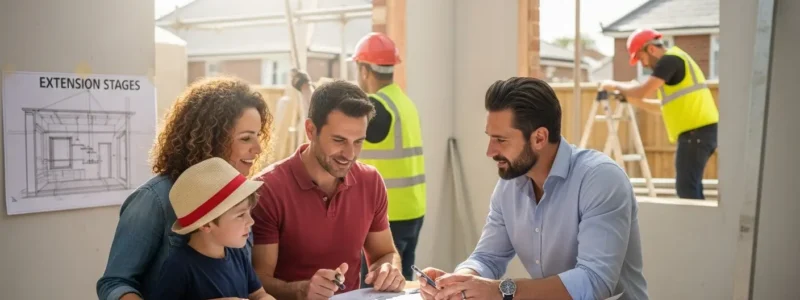Did you know that over 60 percent of London homeowners consider extending their property instead of moving? That decision leads into a maze of unfamiliar terms and rules that can easily cause confusion. Home extension terminology shapes everything, from your planning options to your project’s final cost, so getting to grips with the basics can help you avoid setbacks and communicate confidently throughout your renovation.
Key Takeaways
| Point | Details |
|---|---|
| Understand Planning Terms | Familiarity with terms like ‘permitted development’ and ‘full planning permission’ is crucial for a smooth home extension process. |
| Choose the Right Extension Type | Assess property layout and budget to select an extension type that maximizes space and adheres to planning regulations. |
| Be Aware of Financial Implications | Recognizing cost-related terms and build methods can significantly impact your budget and overall project feasibility. |
| Avoid Common Pitfalls | Thorough research and professional advice are essential to circumvent misconceptions that can derail extension projects. |
Table of Contents
- Understanding Home Extension Terminology Basics
- Types Of Extensions And Key Distinctions
- Essential Terms In Design And Planning
- Planning Permission, Legal And Regulatory Terms
- Cost Terminology And Contractual Clauses
- Common Misconceptions And Mistakes To Avoid
Understanding Home Extension Terminology Basics
When diving into home extensions in London, understanding the fundamental terminology can transform a potentially overwhelming process into a clear, manageable journey. Planning permission and development rights form the cornerstone of any successful home extension project, defining the legal boundaries and possibilities for your property transformation.
According to the Planning Portal, key terminology you’ll encounter includes:
- Permitted Development Rights: These are specific modifications you can make to your property without requiring formal planning permission
- Full Planning Permission: A comprehensive approval needed for significant structural changes or extensions that fall outside standard permitted development
- Outline Permission: An initial approval indicating potential for development, subject to further detailed specifications
Navigating these terms requires understanding subtle but critical distinctions. Our guide on home extensions offers deeper insights into how these classifications impact your specific project. For instance, not all home improvements require the same level of bureaucratic oversight – some minor modifications can be completed under permitted development, while more extensive transformations demand comprehensive planning approvals.
The complexity of extension terminology shouldn’t discourage you. By familiarising yourself with these fundamental concepts, you’ll be better equipped to communicate effectively with architects, builders, and local planning authorities, ensuring a smoother path from initial concept to completed project.
Types of Extensions and Key Distinctions
Home extensions come in various shapes, sizes, and designs, each offering unique solutions for expanding your living space. Rear extensions and side return extensions are among the most popular choices for London homeowners looking to maximise their property’s potential.
According to Resi’s comprehensive guide, the primary types of home extensions include:
- Single-storey extensions: Ground level additions typically extending kitchen or living areas
- Double-storey extensions: Providing additional floor space across two levels
- Loft conversions: Transforming unused attic space into functional living areas
- Wraparound extensions: Combining side and rear extensions for maximum spatial flexibility
Homebuilding’s research highlights critical distinctions between extension types. For instance, a lean-to extension differs significantly from a garden room, with each offering distinct architectural characteristics and planning considerations. Some extensions like porches or conservatories might fall under permitted development, while more substantial structural changes require comprehensive planning permissions.
Choosing the right extension type depends on multiple factors: your property’s existing layout, budget, desired additional space, and local planning regulations. By understanding these key distinctions, you can make an informed decision that not only enhances your living space but also potentially increases your property’s market value.

Here’s a summary of the main extension types and their key characteristics:
| Extension Type | Typical Location | Space Provided | Planning Permission Required |
|---|---|---|---|
| Single-storey | Rear or side of home | Additional ground floor | Sometimes Depends on size |
| Double-storey | Rear, side, or wraparound | Two levels of new space | Usually required |
| Loft conversion | Attic/roof space | Extra bedroom/office | Sometimes Varies by scope |
| Wraparound | Combines side & rear | Maximal flexibility | Usually required |
| Lean-to | Side or rear | Modest ground floor area | Sometimes permitted |
| Garden room | Separate in garden | Outbuilding only | Often permitted |
Essential Terms in Design and Planning
Designing a home extension involves navigating a complex landscape of technical terminology and regulatory requirements. Outline planning permission serves as a crucial initial step in this process, allowing homeowners to gain preliminary approval for their extension’s basic parameters before diving into detailed design specifics.
According to Wikipedia’s planning guidance, outline planning permission enables you to:
- Secure early approval for the extension’s scale and fundamental nature
- Defer detailed matters like layout, appearance, and landscaping to subsequent stages
- Provide a strategic framework for your extension project before committing significant resources
Another critical concept is the Article 4 direction, which can dramatically impact your extension plans. Research indicates that local authorities can use this planning control tool to restrict permitted development rights in specific areas, such as conservation zones. This means that what might typically be a straightforward home improvement could suddenly require full planning permission.
Our comprehensive extension guide offers deeper insights into navigating these complex planning landscapes. Understanding these terms isn’t just bureaucratic necessity—it’s about strategically positioning your project for smooth approval and minimising potential future complications. By mastering these essential planning and design terminologies, you’ll be better equipped to transform your home extension vision into a successful reality.
Planning Permission, Legal and Regulatory Terms
Understanding the legal landscape of home extensions requires navigating a complex web of regulatory terminology that can significantly impact your project’s feasibility. At the heart of this framework lies the critical concept of ‘development’, which legally defines the types of building works that require formal planning permission.
According to Wikipedia’s overview of UK planning permission, key legal terms you’ll encounter include:
- Development: Any building, engineering, mining, or other operations that change land use
- Planning Conditions: Specific requirements attached to a permission grant
- Planning Titles: Legal designations that determine permissible land use and modifications
The National Planning Policy Framework introduces an additional critical concept: a presumption in favour of sustainable development. This means that local authorities are encouraged to approve extension projects that demonstrate environmental and community benefits. Our detailed guide on planning permission requirements can help you understand how these broad policy principles translate into practical approval processes.
The regulatory landscape might seem intimidating, but it’s designed to ensure responsible development. By understanding these legal terms, you’ll be better equipped to navigate the planning permission process, anticipate potential challenges, and increase your chances of a successful home extension project.
![]()
Cost Terminology and Contractual Clauses
Navigating the financial landscape of home extensions requires understanding a complex set of cost terminology that can significantly impact your project’s budget and contractual arrangements. The financial complexity goes beyond simple square metre calculations, involving nuanced considerations of construction methods and design strategies.
Homebuilding’s research highlights critical cost-related terms homeowners should understand:
- Build Method Pricing: Different construction techniques dramatically influence overall project expenses
- Pre-fab Costing: Prefabricated extensions can offer more predictable pricing structures
- Structural Assessment Fees: Additional costs for engineering evaluations and site-specific design requirements
According to Resi’s cost-effectiveness guide, some strategic approaches can optimize your financial investment:
- Double-storey extensions often provide lower cost per square metre
- Over-structure extensions can reduce foundational footprint costs
- Simplified design approaches can substantially decrease complexity and associated expenses
Our project management guide offers deeper insights into managing these financial intricacies. Understanding these cost terminologies isn’t just about budgeting—it’s about making informed decisions that balance your design aspirations with financial practicality, ensuring your home extension delivers maximum value without unexpected financial surprises.
Common Misconceptions and Mistakes to Avoid
Home extension projects are riddled with potential pitfalls that can transform what seems like a straightforward improvement into a complex, costly endeavour. Misconceptions about planning, design, and regulatory requirements can derail even the most well-intentioned renovation plans.
Resi’s comprehensive research reveals several critical misconceptions homeowners frequently encounter:
- Conservatory fallacy: Assuming low-cost conservatories automatically add value (they can actually devalue your property)
- Permitted development trap: Believing wrap-around extensions automatically qualify for permitted development rights
- Cost-cutting shortcuts: Underestimating the importance of professional design and structural assessments
Homebuilding’s expert guidance highlights additional potential mistakes, particularly with side return and double-storey extensions:
- Neighbour boundary issues: Overlooking potential access and overlooking complications
- Structural complexity: Underestimating the need for detailed services checks, including drainage and foundation requirements
- Regulatory blind spots: Failing to fully understand specific planning restrictions in your local area
Our comprehensive extension guide can help you navigate these potential pitfalls. The key is approaching your extension project with thorough research, professional advice, and a realistic understanding of the complexities involved. Avoiding these common misconceptions can save you significant time, money, and potential legal complications.
Confused by Extension Jargon? Let Us Make It Simple for You
Tackling a home extension in London is challenging enough without the complication of complex terminology like permitted development rights, planning permission and design concepts. It is easy to feel uncertain about choosing the right type of extension or misunderstanding essential regulatory and cost terms, which can lead to wasted time, expensive mistakes or unnecessary stress. Find the clarity you need with our specialist support. Explore our collection of helpful articles and guides tailored for London homeowners on our Planning & Permissions for Home Extensions page.
With over 20 years of experience, Reltic Extend handles every stage of your extension journey from planning to project management, ensuring legal compliance and lasting quality. If you are ready to move beyond the jargon and unlock practical solutions, reach out today through our contact page. Take the first step now towards a smooth, transparent and expertly managed home extension.
Frequently Asked Questions
What are Permitted Development Rights?
Permitted Development Rights allow homeowners to make certain modifications to their properties without the need for formal planning permission. These rights vary based on property type and location.
What is Full Planning Permission?
Full Planning Permission is a comprehensive approval required for significant changes to a property, such as major extensions that do not fall under Permitted Development Rights. It involves submitting detailed plans to the local planning authority.
What is the difference between Outline Permission and Full Planning Permission?
Outline Permission provides initial approval for the basic parameters of a development, while Full Planning Permission requires detailed designs and specifications. Outline Permission is typically the first step in the planning process.
What types of home extensions are available?
Common types of home extensions include single-storey extensions, double-storey extensions, loft conversions, wraparound extensions, lean-to extensions, and garden rooms. Each type has its own unique characteristics and planning requirements.





